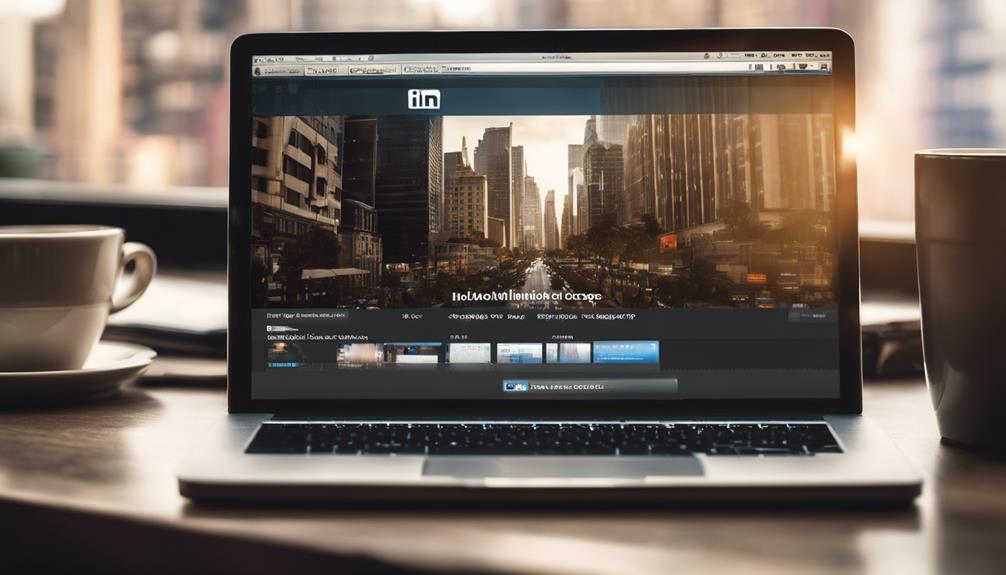Using LinkedIn for B2B Marketing Strategies
As you consider incorporating LinkedIn into your B2B marketing strategy, you're likely wondering what sets this platform apart from others. With over 700 million professionals on the site, LinkedIn offers a unique opportunity to connect with your target audience and build meaningful relationships. But, simply having a presence on the platform isn't enough – you need a clear plan to drive real results. What does a successful LinkedIn strategy look like, and how can you tailor it to your business goals? The answer lies in understanding the platform's nuances and leveraging its features to your advantage – but where do you start?
Key Takeaways
- Develop a content strategy that speaks directly to the B2B audience's needs, interests, and pain points on LinkedIn.
- Optimize the company page with accurate information, consistent branding, and relevant industry keywords.
- Use paid advertising on LinkedIn to target specific demographics and increase the likelihood of driving conversions and generating leads.
- Engage in LinkedIn groups and participate in discussions to demonstrate thought leadership and build meaningful relationships with the target audience.
Crafting Compelling LinkedIn Content
To craft compelling LinkedIn content that resonates with your B2B audience, you'll need to develop a content strategy that speaks directly to their needs, interests, and pain points.
This involves creating a content calendar that outlines your posting schedule, topics, and formats. A well-planned content calendar guarantees consistency, reduces last-minute scrambles, and helps you track performance.
When developing your content strategy, consider incorporating visual storytelling techniques to capture your audience's attention.
LinkedIn users are 20 times more likely to engage with visual content, such as images, videos, and infographics, than plain text.
Use high-quality visuals to break up text, illustrate complex concepts, and showcase your brand's personality.
Building a Strong Company Page
When building a strong company page on LinkedIn, you'll want to focus on optimizing your profile to increase visibility and credibility.
This involves completing your company's profile with accurate and up-to-date information, including a compelling description, relevant keywords, and a consistent brand voice.
Optimize Your Profile
Crafting a strong company page on LinkedIn is crucial for establishing your brand's online presence, as it serves as a digital storefront that showcases your company's values, mission, and products to potential customers, partners, and employees. To optimize your profile, start by guaranteeing your company's visual identity is consistent across all platforms. This includes using the same logo, color scheme, and typography.
| Element | Best Practice |
|---|---|
| Profile Picture | Use your company logo |
| Cover Image | Showcase your products or services |
| Tagline | Clearly state your company's mission |
| Description | Write a concise and compelling summary |
| Keywords | Include relevant industry keywords |
Your personal brand is also essential to your company's LinkedIn presence. Guarantee that your executives and employees have complete and up-to-date profiles, showcasing their expertise and thought leadership. This will help establish your company as a trusted authority in your industry. By optimizing your profile, you'll be able to attract and engage with your target audience, ultimately driving more leads and sales for your business.
Showcase Company Culture
By highlighting your company's culture on LinkedIn, you're not only attracting potential customers but also top talent, as a strong company culture is a key differentiator in today's competitive job market.
To showcase your company culture, focus on creating engaging content that gives your audience a glimpse into your company's values, mission, and work environment.
Share Company Perks: Highlight the benefits and perks that set your company apart, such as flexible work hours, professional development opportunities, or wellness programs.
Employee Spotlights: Feature your employees and share their stories, experiences, and achievements to give your audience a personal connection to your company.
Behind-the-Scenes Content: Share photos or videos of company events, team-building activities, or daily life in the office to give your audience a sense of what it's like to work at your company.
Thought Leadership: Share articles, blog posts, or videos that showcase your company's expertise and thought leadership in your industry, highlighting your company's values and mission.
Leveraging LinkedIn Sponsored Content
You're likely already familiar with LinkedIn's organic content options, but leveraging LinkedIn sponsored content can substantially amplify your B2B marketing efforts, allowing you to reach a wider audience and drive more conversions.
To maximize your ROI, start by developing a thorough content calendar that aligns with your overall marketing strategy. This will help you plan and schedule sponsored content in advance, guaranteeing consistent messaging and peak ad performance.
When creating sponsored content, focus on ad targeting to guarantee your message resonates with the right audience. LinkedIn offers a range of targeting options, including job title, industry, company size, and more.
By targeting specific demographics, you can increase the likelihood of driving conversions and generating leads. Consider using LinkedIn's lead generation forms, which allow users to submit their contact information directly from the ad.
This can help streamline your lead collection process and provide valuable insights into your target audience. By incorporating sponsored content into your LinkedIn marketing strategy, you can take your B2B marketing efforts to the next level and achieve tangible results.
Joining and Participating in Groups
Strategically joining and participating in LinkedIn groups can play a significant role in elevating your B2B marketing strategy and expanding your professional network. As a marketer, you can substantially benefit from participating in groups that are relevant to your industry and niche. This strategic approach enables you to showcase your expertise, share valuable industry insights, and position your company as a thought leader in the space.
Participating in LinkedIn groups can impact your B2B marketing efforts in a few key ways:
Gain industry insights by participating in discussions, sharing perspectives, and staying updated on industry news
Demonstrate thought leadership by sharing your company's unique expertise, sharing content, and offering guidance to others in the group
Build meaningful relationships by engaging in authentic and informative conversations
Enhance brand awareness and generate interest in your products or services among the group's targeted audience
When selecting LinkedIn groups, it's vital to be intentional about your participation strategy to avoid getting overwhelmed and failing to effectively execute on the full value proposition offered.
Utilizing LinkedIn InMail Marketing
As you expand your B2B marketing efforts on LinkedIn, incorporating InMail marketing into your strategy can help you target specific decision-makers and influencers, increase conversion rates, and drive more qualified leads to your sales team.
By leveraging InMail personalization, you can create tailored messages that resonate with your target audience, increasing the likelihood of engagement and conversion. This can be achieved by using personalized greetings, referencing specific job titles or industries, and highlighting relevant content or solutions.
To streamline your InMail marketing efforts, consider implementing InMail automation. This allows you to set up triggered campaigns that send targeted messages to specific groups or individuals, saving you time and increasing efficiency.
For example, you can automate InMails to new connections, leads who've downloaded your content, or attendees of your webinars. By combining personalization and automation, you can create a powerful InMail marketing strategy that drives real results for your business.
Creating Targeted LinkedIn Ads
By crafting targeted LinkedIn ads, businesses can effectively reach and engage their ideal audience, increasing brand awareness, generating quality leads, and driving conversions.
To achieve this, you'll need to leverage LinkedIn's ad targeting options, which allow you to reach specific professionals based on their job title, industry, company size, and more.
When creating your LinkedIn ad campaign, consider the following strategies to maximize your ROI:
- Define your target audience: Use LinkedIn's targeting options to reach the right professionals, including job title, industry, company size, and more.
- Set a clear ad budget allocation: Allocate your budget effectively by setting a daily or total budget for your campaign.
- Optimize your ad creative: Use eye-catching visuals and compelling copy to grab the attention of your target audience.
Measuring LinkedIn Campaign Success
To effectively gauge the performance of your LinkedIn campaigns and make data-driven decisions, you'll need to track and analyze key metrics that align with your marketing objectives.
This involves setting campaign benchmarks that measure the success of your efforts. Establishing clear benchmarks allows you to evaluate the effectiveness of your campaigns and identify areas for improvement.
When measuring campaign success, it is vital to track metrics such as click-through rates, conversion rates, and cost per lead.
These metrics provide valuable insights into the performance of your campaigns and help you optimize your marketing strategy. Additionally, ROI tracking is pivotal to understanding the financial impact of your LinkedIn campaigns.
Identifying and Engaging Influencers
You'll need to identify and engage influencers who've established credibility and trust with your target audience on LinkedIn. This is a vital step in your B2B marketing strategy, as influencers can help amplify your message and expand your reach.
To find the right influencers, you'll need to conduct thorough influencer research. This involves analyzing LinkedIn profiles, posts, and engagement metrics to identify thought leaders in your industry.
Some key factors to weigh when identifying influencers on LinkedIn:
- Relevance: Are they talking about topics related to your business or industry?
- Reach: How large is their following, and are they actively engaging with their audience?
- Resonance: Are their posts generating significant likes, comments, and shares?
Sharing User-Generated Content
Sharing user-generated content on LinkedIn can be a powerful way to build trust and credibility with your target audience, as it showcases real-world examples of how your product or service has helped others achieve their goals.
By sharing content created by your customers, partners, or employees, you're providing social proof that your solution is effective and reliable. This can be especially effective in B2B marketing, where decision-makers are often looking for evidence of a product's or service's value.
To effectively share user-generated content on LinkedIn, focus on content curation. This involves selecting and showcasing the most relevant and impactful content from your users.
Look for testimonials, case studies, and success stories that demonstrate the benefits of your product or service. Use LinkedIn's publishing platform to share these stories, and consider using eye-catching visuals to make them stand out.
Analyzing LinkedIn Page Performance
To optimize your LinkedIn marketing strategy, you need to track and analyze your page's performance regularly.
You'll want to focus on page engagement metrics, such as likes, comments, and shares, to gauge how well your content is resonating with your audience.
Page Engagement Metrics
When analyzing your LinkedIn page's performance, tracking page engagement metrics is crucial to understanding how well your content resonates with your target audience and identifying areas for improvement. By monitoring these metrics, you can refine your content strategy to better engage your followers and drive meaningful conversations.
Some key page engagement metrics to track:
Follower growth rate: Monitor the rate at which your follower base is growing or declining to gauge the effectiveness of your content and engagement strategies.
Post engagement rate: Track likes, comments, and shares on individual posts to understand what types of content resonate with your audience.
Page views and unique visitors: Analyze the number of people visiting your page and the number of unique visitors to understand how effectively your content is attracting new eyes.
Engagement by content type: Track engagement metrics by content type (e.g., video, image, text-only posts) to identify what types of content drive the most engagement.
Content Performance Analysis
By analyzing your LinkedIn page's content performance, you can gain valuable insights into what's working, what's not, and where to adjust your strategy to maximize engagement, drive conversions, and ultimately boost your B2B marketing efforts.
To analyze your content performance, you need to track the right metrics. Here are some key content metrics to focus on:
| Metric | Description | Goal |
|---|---|---|
| Engagement Rate | Measures the percentage of users who interact with your content | Increase engagement rate by 20% |
| Click-Through Rate (CTR) | Measures the percentage of users who click on your content | Increase CTR by 15% |
| Conversion Rate | Measures the percentage of users who complete a desired action | Increase conversion rate by 10% |
| Average Watch Time | Measures the average time users spend watching your video content | Increase average watch time by 30 seconds |
Frequently Asked Questions
Can I Use Linkedin for B2C Marketing Strategies as Well?
You can leverage LinkedIn for B2C marketing if your target audience is present on the platform and you create content relevance that resonates with them, but consider its professional tone and potential audience differences from other channels.
How Often Should I Post on My Company Page?
You'll want to determine your posting frequency by creating a content calendar that aligns with your audience's engagement patterns. Aim for 3-5 posts per week, but adjust based on your analytics to optimize reach and clicks.
Can I Schedule Posts in Advance on Linkedin?
You can streamline your content strategy by using a content calendar and leveraging LinkedIn's auto-scheduling feature, allowing you to plan and schedule posts in advance, saving time and ensuring consistency.
Are Linkedin Ads More Effective Than Google Ads?
When deciding between LinkedIn ads and Google ads, you'll want to compare their ad targeting capabilities and ad metrics. LinkedIn's targeting options are often more precise, focusing on professional characteristics, while Google ads target broader demographics and search queries.
Can I Use Linkedin for Customer Service and Support?
You can leverage LinkedIn to address customer feedback and resolve support tickets by engaging with customers, responding to comments, and using LinkedIn's messaging feature to provide personalized support, enhancing your overall customer service strategy.
Conclusion
By implementing these strategies, you'll be able to effectively utilize LinkedIn for your B2B marketing efforts.
You'll be crafting compelling content, building a strong company page, leveraging sponsored content, and engaging with influencers.
You'll also be measuring campaign success, analyzing page performance, and sharing user-generated content.
By taking a thorough approach, you'll be able to build meaningful relationships, enhance brand awareness, and drive lead generation.
This will ultimately help you achieve your B2B marketing goals.







